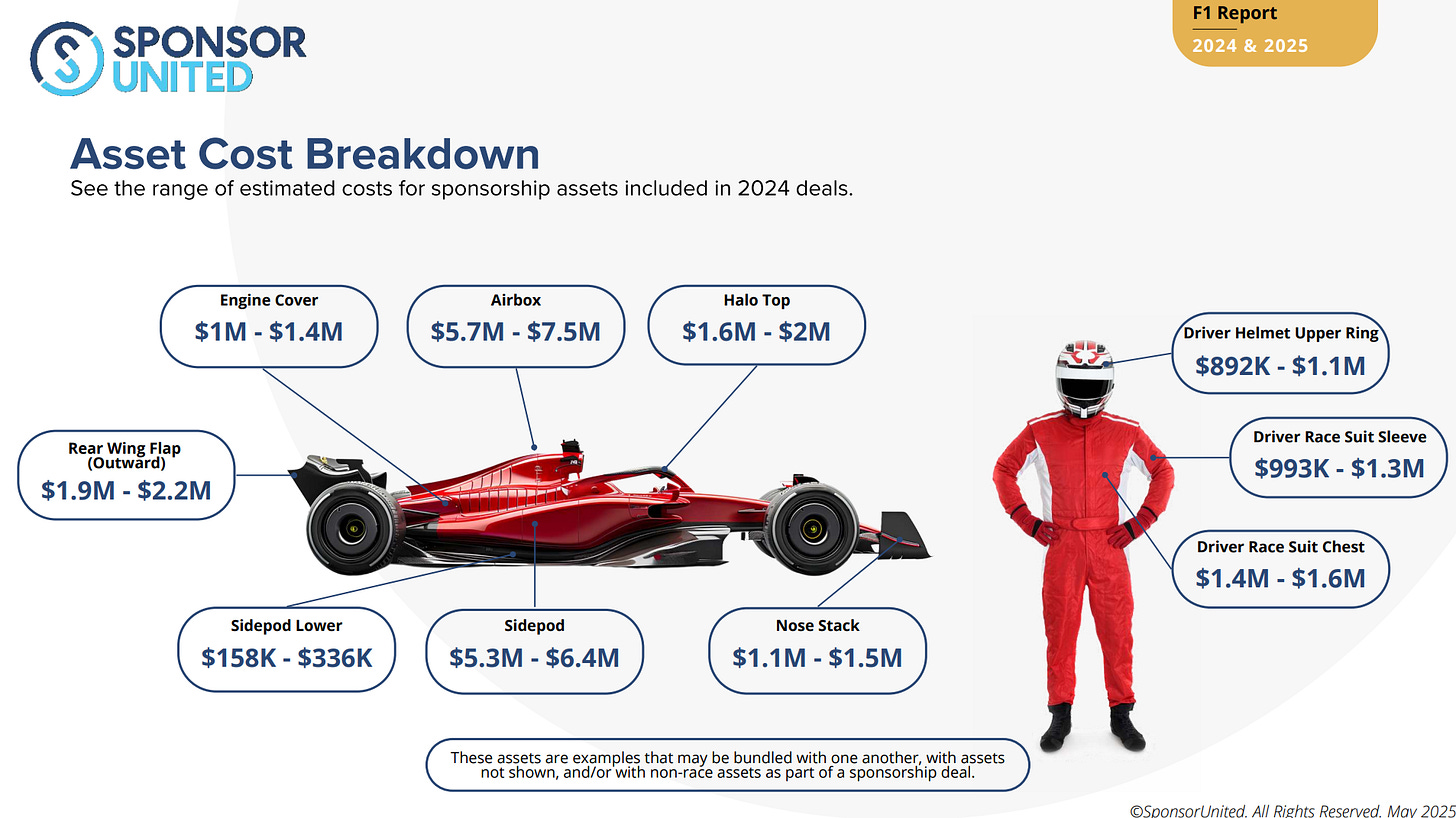F1’s $2 Billion Power Play: How Formula 1 Became the Pinnacle of Sponsorship ROI
Formula 1 is winning where it matters, massive brand value, global cultural reach, and unrivalled sponsorship economics.
In the battle for global sponsorship supremacy, it’s not just about who signs the most deals; it’s about who signs the smartest ones. And right now, nobody is doing that better than Formula 1. The 2024 SponsorUnited Report confirms what many in the sports marketing world have felt for years: F1 is the most valuable playground in sport for brands with ambition.
Despite having just ten teams, compared to the NFL’s 32 or the NBA’s 30, Formula 1 generated $2.04 billion in sponsorship revenue in 2024, more than the MLB and NBA, and second only to the NFL. What’s even more revealing? The average F1 sponsorship deal is worth over $6 million. That’s nearly eight times the size of an average NFL sponsorship deal.
It’s not quantity, it’s influence. And F1 knows how to charge a premium for it.
The business case is compelling. A single team in F1 can command more revenue per deal than entire franchises in other leagues. Mercedes-AMG Petronas, Red Bull Racing, and Scuderia Ferrari HP collectively generated close to $600 million, largely fueled by multi-year, cross-category brand alliances.
At the top end, tech partnerships, like Oracle with Red Bull or HP with Ferrari, accounted for over $500 million in 2024. When the CMO wants global scale and prestige, Formula 1 is the meeting point.
There’s also the halo effect of driver influence. Lewis Hamilton remains the most followed F1 athlete with almost 40 million Instagram followers alone, eclipsing most athletes, outside of a handful.
But it’s not just legacy drivers, names like Lando Norris, Charles Leclerc, and Max Verstappen are marketing machines in their own right, racking up millions in branded engagements. This blend of talent and social leverage makes each partnership a cultural event, not just a sticker on a car.
At a time when traditional sponsorship ROI is under more scrutiny than ever, Formula 1 is delivering consistent, premium value. Why? Because every inch of branding real estate is a data-informed asset.
Want a spot on the sidepod? That’ll run you up to $6.4 million. Prefer the airbox? You’re looking at $7.5 million. Even helmet visor strips or race suit sleeves are monetised with laser precision, bundling media exposure with exclusive partner rights in a way few other sports have mastered.
Follow me for more sports and life updates: Instagram
The sport’s strength lies in its control of scarcity and spectacle. With just 24 races, each event becomes a marketing tentpole. Brands get global reach with local relevance. One weekend it’s Monaco, next it’s Singapore, then Las Vegas. This rotational luxury tour gives partners a red carpet on every continent. It’s a strategy leagues like the NFL have begun to emulate with international fixtures.
What’s more, the alignment between the team and sponsor feels organic. Look at Atlassian Williams Racing. Their new title sponsorship with Atlassian isn’t just a logo slapped on, it’s a full integration of enterprise software into the team’s performance and project management. That’s not advertising, that’s product demonstration on a global stage.
And then there’s Eni’s return after a 25-year absence, now powering Alpine as the Official Energy and Fuel Partner. Moves like this underscore the new age of sustainability optics and energy brand repositioning through sport.
Meanwhile, the sport has always attracted the luxury titans. LVMH has activated six brands across the 2025 season so far. In other categories, Nestlé and Barilla aren’t just throwing money, they’re rethinking activations entirely, with paddock pasta bars and KitKat digital exclusives. This isn’t perimeter signage, it’s lifestyle integration.
But F1’s crown jewel isn’t just high-value sponsors. It’s data. Every asset, every helmet, suit, wing flap, is algorithmically valued, bundled, and compared across teams. This pricing transparency arms teams and brands with leverage and insight. It also futureproofs the model against the kind of vague valuation that has hurt sponsorship’s credibility in other sports.
In many ways, F1 is now the benchmark. Yes, the other leagues may have more teams, more fans, and, for the NFL in particular, more money. But F1 owns the crown for value per touchpoint, global cultural cachet, and strategic partner alignment. It’s not just a sport, it’s a world tour, a brand showcase, and a corporate hospitality engine all rolled into one.
And as new brands get onboard, the signal is clear: if you want to go global fast, you need to get on the grid.
Thanks for reading, David Skilling.
If you’re interested in the full SponsorUnited Report. Check it out here.
Follow me on LinkedIn | X | Instagram
If you hit the like button, you’ll be doing me a huge favour, and if your business needs sports writing, wants to discuss advertising, or you have PR stories to pitch, feel free to get in contact.
If you know someone who will enjoy this article, please share it with them.





